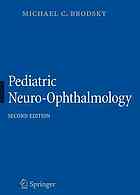Pediatric Neuro-Ophthalmology 2010
دانلود کتاب پزشکی مغز و اعصاب کودکان و جراحی مغز و اعصاب
| نویسنده |
Michael C. Brodsky |
|---|
| تعداد صفحهها |
550 |
|---|---|
| نوع فایل |
|
| حجم |
184 Mb |
| سال انتشار |
2010 |
89,000 تومان
“به دلیل نمایش سخاوتمندانه سیستم بینایی آوران در مغز، بیماری عصبی ممکن است بینایی را به عنوان یک علامت اپیزودیک یا به عنوان یک اثر ثانویه بیماری مختل کند. برعکس، اختلالات رشد اولیه بینایی اغلب سیستم های کنترل حرکت چشم را مختل می کند. منجر به اختلالات پیچیده ای مانند نیستاگموس، استرابیسم و تورتیکولی می شود. علائم و نشانه های بیماری عصبی ماهیت ناشناخته دارند، ارائه یک چالش تشخیصی گیج کننده داروهای عصبی و درمان های جراحی مغز و اعصاب می توانند منجر به اختلال عملکرد چشم شوند که تشخیص آن از پیشرفت بیماری ممکن است دشوار باشد تأخیر قابل توجه در تشخیص، و اغلب تحت آزمایشهای تشخیصی گسترده (و گرانقیمت) قرار میگیرد. مقالات علمی در مورد اختلالات خاص در مجلات فوق تخصصی پزشکی تکثیر میشوند. -چشمشناسی متشکل از مجموعهای متمایز از بیماریهای بزرگسالان، منجر به ظهور آن به عنوان یک رشته مطالعاتی اختصاصی شده است.
“از زمان انتشار اولیه “عصبشناسی کودکان چشم پزشکی کودکان” تقریباً چهارده سال پیش، علاقه به این رشته افزایش یافته است. کنفرانس های فوق تخصصی چشم پزشکی و مغز و اعصاب اطفال اغلب شامل سمپوزیوم هایی است که به پیشرفت های اخیر در چشم پزشکی اعصاب کودکان اختصاص دارد. پیشرفتهای فنی در تصویربرداری عصبی منجر به طبقهبندی خودکار یکپارچهتر بیماریهای عصبی-چشمی کودکان شده است. درک ما از اختلالات رشد عصبی سیستم بینایی گسترش یافته است، یکپارچههای باستانی به اجزای سازنده تجزیه شدهاند، مکانیسمهای مولکولی زیربنایی در مرکز قرار گرفتهاند، و زیربنای ژنتیکی تعیینکننده شدهاند. اکنون می توان تغییرات رشدی را در سطح ژن مشاهده کرد و بعد جدیدی به درک ما از پاتوژنز بیماری اضافه کرد. طبقه بندی های جدید اکنون شامل شرایط بالینی متفاوتی است. تعاریف توصیفی با تعاریف ابزاری جایگزین شده اند و تعاریف بالینی جایگزین تعاریف ژنتیکی شده اند. مفهوم ما از پاتوژنز تجدید نظر شده و در برخی موارد لغو شده است. شاهد این پیشرفتهای چشمگیر، من را بر آن داشت تا اولین نسخه چشم پزشکی اعصاب اطفال را در این نسخه جدید و تجدیدنظر شده تقویت و گسترش دهم.
“در چاپ اول این کتاب، هدف ما ارائه ویژگیهای بالینی، ارزیابی تشخیصی و گزینههای درمانی برای اختلالات عصبی-چشمی شایع دوران کودکی بود. در انجام این کار، کتاب را به گونهای طراحی کردیم که ارائه شود. سفری روایی از طریق فرآیندهای فکری درگیر در مدیریت بالینی این اختلالات.در این نسخه، من فرمول روایی اصلی کتاب اصلی را حفظ کردهام، در حالی که کاوش این اختلالات بصری پیچیده را در زمینه بسیاری از پیشرفتهای علمی جدید گسترش میدهم. و اکتشافاتی که آشکار شده است. – از مقدمه تا چاپ دوم.
"Due to the generous representation of the afferent visual system within the brain, neurological disease may disrupt vision as a presenting symptom or as a secondary effect of the disease. Conversely, early developmental disturbances of vision often disrupt ocular motor control systems, giving rise to complex disorders such as nystagmus, strabismus, and torticollis. The signs and symptoms of neurological disease are elusive by their very nature, presenting a confounding diagnostic challenge. Neurological medications and neurosurgical treatments can produce neuro-ophthalmological dysfunction that can be difficult to distinguish from disease progression. Affected patients may experience substantial delays in diagnosis, and are often subjected to extensive (and expensive) diagnostic testing. Scientific articles pertaining to specific disorders are scattered throughout medical subspecialty journals. These children continue to "fall through the cracks" of our medical education system. The increasing recognition that pediatric neuro-ophthalmology comprises a distinct set of diseases from those seen in adults has led to its emergence as a dedicated field of study.
"Since the original publication of Pediatric Neuro-Ophthalmology nearly fourteen years ago, interest in the field has burgeoned. Pediatric ophthalmology and pediatric neurology subspecialty conferences often include symposia dedicated to recent advances in pediatric neuro-ophthalmology. Technical advances in neuroimaging have given rise to a more integrated mechanistic classification of neuro-ophthalmological disease in children. Our understanding of neurodevelopmental disorders of the visual system has expanded, longstanding monoliths have been dissembled into component parts, basic molecular mechanisms have taken center stage, and genetic underpinnings have become definitional. Evolutionary alterations can now be observed at the level of the gene, adding a new dimension to our understanding of disease pathogenesis. New classifications now encompass clinically disparate conditions. Descriptive definitions have been supplanted by mechanistic ones, and clinical definitions superseded by genetic ones. Our concept of disease pathogenesis has been revised and in some cases overturned. Bearing witness to these remarkable advancements has compelled me to enhance and expand the first edition of Pediatric Neuro-Ophthalmology into this new and revised one.
"In the first edition of this book, our goal was to present the clinical characteristics, diagnostic evaluation, and therapeutic options for the common neuro-ophthalmologic disorders of childhood. In so doing, we designed the book to be provide a narrative journey through the thought processes involved in the clinical management of these disorders. In this edition, I have retained the basic narrative format of original book, while expanding the exploration of these complex visual disorders in the context of the many new scientific advancements and discoveries that have come to light. These conditions are fun to diagnose, fascinating to understand, and gratifying to manage." --from the Preface to the 2nd Edition.




